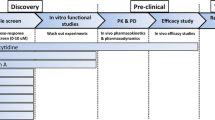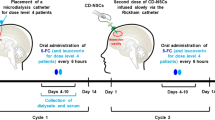Abstract
We investigated 5-fluoro-2′-deoxyuridine (FdUrd) as a potential agent for intrathecal treatment of malignant brain tumors with meningeal dissemination. We examined the neurotoxicity of FdUrd in vitro using primary cultures of neurons from C57BL/6 mice (ED14). Tumoricidal activity was also studied in four glioma cell lines and one medulloblastoma cell line. In addition, thymidine phosphorylase (TPase) and thymidine kinase (TK), which are key enzymes for FdUrd metabolism, were measured in the cerebrospinal fluid (CSF) of 36 patients with brain tumors. The antitumor activity of FdUrd for murine glioma cells was approximately 20- to 200-fold higher than that of 5-fluorouracil (5-FU). Against human cell lines, it was 3- to 500-fold higher than that of 5-FU. The neurotoxic effect of FdUrd on cultured neurons was far less than that of 5-FU or 5-fluorouridine (FUrd). Cerebrospinal fluid contained no detectable thymidine phosphorylase in most patients with brain tumors. Several studies have indicated that FdUrd is rapidly converted to 5-FU in the presence of thymidine phosphorylase, so that a high dose of FdUrd must be administered to obtain good efficacy. However, a high dose FdUrd frequently cause severe toxicity. In contrast, the data obtained here suggest that no enzymatic conversion of FdUrd to 5-FU should occur in the CSF. In addition, FdUrd has an excellent antitumor activity and minimal neurotoxicity. We therefore conclude that intrathecal FdUrd is a potential therapy for CSF dissemination of malignant brain tumors.
Similar content being viewed by others
References
_Hartmann K-U, Heidelberger C: Studies on fluorinated pyrimidines XIII. Inhibition of thymidylate synthetase. J Biol Chem 236: 3006–3013, 1961
Cohen SS, Flaks JG, Barner HD, Loeb MR, Lichtenstein J: The mode of action of 5-fluorouracil and its derivatives. Proc Natl Acad Sci USA 44: 1004–1012, 1958
Laskin JD, Evans RM, Slocum HK, Burke D, Hakala MT: Basis for natural variation in sensitivity to 5-flourouracil in mouse and human cells in culture. Cancer Res 39: 383–390, 1976
Roosa RA, Bradley TD, Law LW, Herzenberg LA: Characterization of resistance to amethopterin, 8-azaguanine and several fluorinated pyrimidines in the murine lymphocytic neoplasm, P388. J Cell Comp Physiol 60: 109–126, 1962
Kanzawa F, Hoshi A, Kuretani K: Differences between 5-fluoro-2′-deoxyuridine and 5-fluorouridine in their cytotoxic effect on growth of murine lymphoma L5178Y cells in in vivo and in vitro systems. Eur J Cancer 16: 1087–1092, 1980
Bosch L, Harbers E, Heidelberger C: Studies on fluorinated pyrimidines. V Effects on nucleic acid metabolism in vitro.Cancer Res 18: 335–343, 1958
Parker WB, Cheng YC: Metabolism and mechanism of action of 5-fluorouracil. Pharmacol Ther 48: 381–395, 1990
Birnie GD, Kroeger H, Heidelberger C: Studies of fluorinated pyrimidines. XVIII. The degradation of 5-fluoro-2′-deoxyuridine and related compounds by nucleoside phosphorylase. Biochemistry 2: 566–572, 1963
Kumanishi T, Ikuta F, Yamamoto T: Brain tumors induced by Rous sarcoma virus, Schmidt-Ruppin strain. III Morphology of brain tumors induced in adult mice. J Natl Cancer Inst 50: 95–109, 1973
Maehara Y, Nakamura H, Nakane Y, Kawai K, Okamoto M, Nagayama S, Shirasaka T, Fujii S: Activities of various enzymes of pyrimidine nucleotide and DNA syntheses in normal and neoplastic human tissues. Gann 73: 289–298, 1982
Kemeny N, Cohen A, Seiter K, Conti JA, Sigurdson ER, Tao Y, Niedzwiecki D, Botet J, Budd A: Randomized trial of hepatic arterial floxuridine, mitomycin, and carmustine versus floxuridine alone in previously treated patients with liver metastases from colorectal cancer. J Clin Oncol 11: 330–335, 1993
Marsh JC, Durivage HJ, Davis C, O'Hollaren K, Pasquale DN, Simonich SA, Voynick IM, Bertino JR: Phase II study of pulse 5-fluoro-2′-deoxyuridine and leucovorin in advanced colorectal cancer patients previously treated with chemotherapy. Am J Clin Oncol 15: 115–118, 1992
Kemeny N, Daly J, Reichman B, Geller N, Botet J, Oderman P: Intrahepatic or systemic infusion of fluorodeoxyuridine in patients with liver metastasis from colorectal carcinoma. A randomized trial. Ann Int Med 107: 459–465, 1987
Rougier P, Laplanche A, Huguier M, Hay JM, Ollivier JM, Escat J, Salmon R, Julien M, Audy JCR, Gallot D, Gouzi JL, Pailler JL, Elisa D, Lacaine F, Roos S, Ratman N, Luboinski M, Lasser P: Hepatic arterial infusion of floxuridine in patients with liver metastases from colorectal carcinoma: Long-term results of a prospective randomized trial. J Clin Oncol 10: 1112–1118, 1992
Roemeling RV, Rabatin JT, Fraley EE, Hrushesky WJM: Progressive metastatic renal cell carcinoma controlled by continuous 5-fluoro-2-deoxyuridine infusion. J Urol 139: 259–262, 1986
Conroy T, Geoffrois L, Guillemin F, Luporsi E, Krakowski I, Spaëth D, Frasie V, Volff D: Simplified chronomodulated continuous infusion of floxuridine in patients with metastatic renal cell carcinoma. Cancer 72: 2190–2197, 1993
Wilkinson MJ, Frye JW, Small EJ, Venook AP, Carroll PR, Ernest ML, Stagg RJ: A phase II study of constant-infusion floxuridine for the treatment of metastatic renal cell carcinoma. Cancer 71: 3601–3604, 1993
Koenig H, Patel A: Biochemical basis for fluorouracil neurotoxicity. Arch Neurol 23: 155–160, 1970
Okeda R, Shibutani M, Matsuo T, Kuroiwa T, Shimokawa R, Tajima T: Experimental neurotoxicity of 5-fluorouracil and its derivatives is due to poisoning by the monofluorinated organic metabolites, monofluoroacetic acid and α-fluoro-β-alanine. Acta Neuropathol 81: 66–73, 1990
Flentje M, Flentje D, Schlag P: Comparison of 5-FU versus FUdr activity in human colorectal cancer using an in vitro clonogenic assay (HTCA). Cancer Chemother Pharmac 18: 223–225, 1986
Koenig H: Neurological action of some pyrimidine analogs. In: Pfeiffer CC, Smythies JR (eds) Internat Rev Neurobiol, Academic Press Inc, New York, 1967, vol 10, pp 199–230
Bryan P: CSF seeding of intracranial tumors: A study of 96 cases. Clin Radiol 25: 355–360, 1974
Giannone L, Greco FA, Hainsworth JD: Combination intraventricular chemotherapy for meningeal neoplasia. J Clin Oncol 4: 68–73, 1986
Wasserstrom WR, Glass JP, Posner JB: Diagnosis and treatment of leptomeningeal metastases from solid tumor: Experience with 90 patients. Cancer 49: 759–772, 1982
Norrell H, Wilson CB, Slagel DE, Clark DB: Leukoencephalopathy following the administration of methotrexate into the cerebrospinal fluid in the treatment of primary brain tumors. Cancer 33: 923–932, 1974
Page KA, Vogel H, Horoupian DS: Intracerebral (parenchymal) infusion of methotrexate: report of a case. J Neurooncol 12: 181–186, 1992
Author information
Authors and Affiliations
Rights and permissions
About this article
Cite this article
Yamada, M., Nakagawa, H., Fukushima, M. et al. In vitro study on intrathecal use of 5-fluoro-2′-deoxyuridine (FdUrd) for meningeal dissemination of malignant brain tumors. J Neurooncol 37, 115–121 (1998). https://doi.org/10.1023/A:1005869226496
Issue Date:
DOI: https://doi.org/10.1023/A:1005869226496




